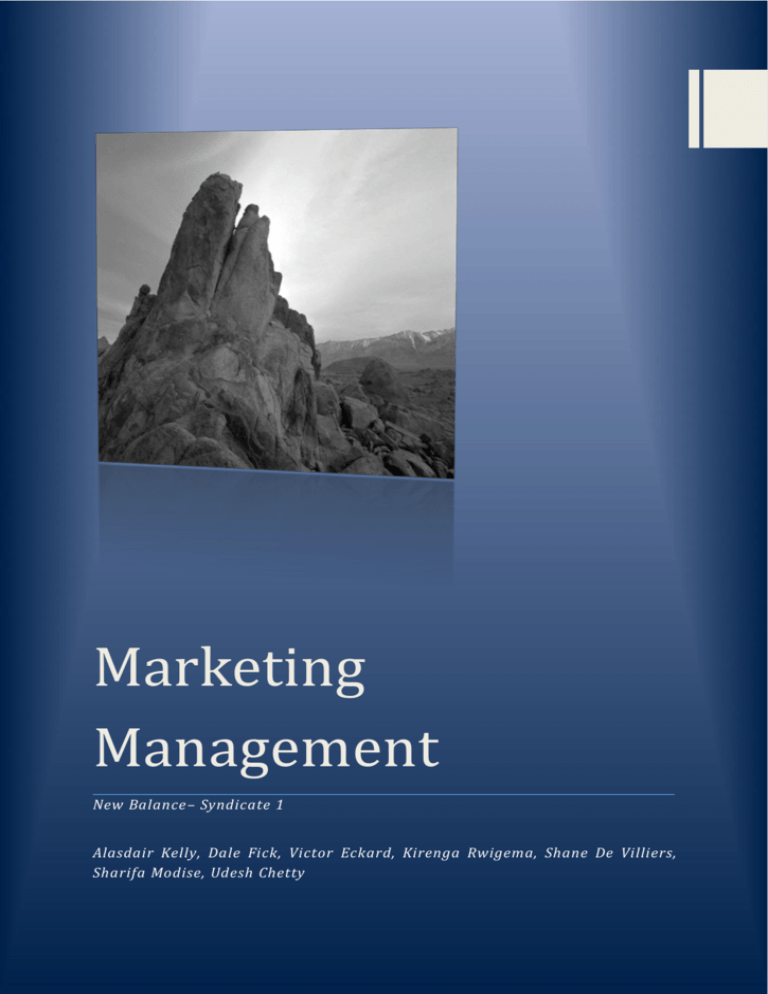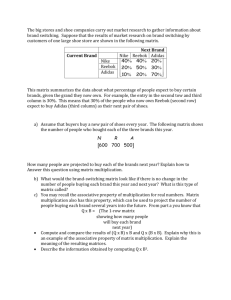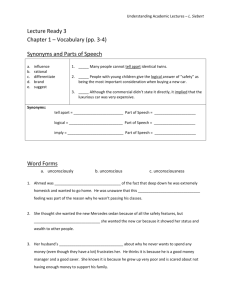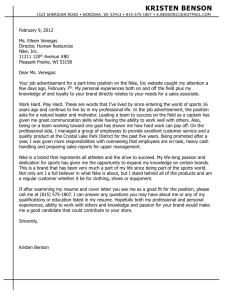
Marketing
Management
New Balance– Syndicate 1
Alasdair Kelly, Dale Fick, Victor Eckard, Kirenga Rwigema, Shane De Villiers,
Sharifa Modise, Udesh Chetty
Contents
Introduction............................................................................................................................................. 2
New Balance - Background...................................................................................................................... 2
Analysis.................................................................................................................................................... 3
PESTEL Analysis.................................................................................................................................... 3
SWOT Analysis..................................................................................................................................... 4
Competitor Analysis.............................................................................................................................5
Perceptual map................................................................................................................................6
Competitor comparison...................................................................................................................6
Porters Generic strategies................................................................................................................... 7
Why would anyone buy New Balance shoes?......................................................................................... 8
Recommendations...................................................................................................................................9
References............................................................................................................................................. 10
1
Introduction
New Balance is facing cross-roads in their organisational journey; they have experienced much
growth in the South African market but have reached a ceiling in their area of focus. In order to
achieve more growth, they are contemplating moving away from their Business-to-Business model
of operation into a more Business-to-Consumer model. This poses a moral dilemma that may have a
potentially large impact on their bottom line – should they pursue growth and move into the market
their own customers occupy thus putting their strong profit-bearing relationships at risk, or should
they remain focussed on their current model and hope to make marginal gains in market share.
A situational analysis putting forth the options available to them at the time follows; we then go into
recommendations that we feel would minimise the potential impact of their actions.
New Balance - Background
New Balance, a manufacturer of sport apparel and footwear can trace its beginnings to the 1900s in
the United States of America; the founder – William J Harvey created the company to cater to the
needs of individuals with problem feet. His main offering was to provide prescription footwear as
well as shoes that had arch support; in order to increase general foot health /well-being.
Subsequently, the organisation changed ownership twice – once in 1954 when it was sold to Eleanor
and Paul Kidd, and another time in 1972 when it was sold to Jim Davis. At the time this case was
written, ownership of New Balance International still belonged to Jim Davis; and, during this tenure,
the organisation had shown substantial growth and could lay claim to being the fourth largest
athletic footwear and apparel company in the world.
New Balance entered the South African market through licenced sales by Futura Footwear. They did
not perform well in these initial stages; however, and when Jim Davis finally came to South Africa in
1999, he realised the large amount of potential for his organisation inherent in South Africa’s sportscrazy population and determined that a New Balance subsidiary would be more profitable than a
mere licensee.
To this aim, John O’Neill (a New Balance USA employee with a good reputation for starting up
subsidiaries) was commissioned to set up an office in Cape Town. He proceeded to recruit Gary Van
Rooyen, ex- Regional Sales Director of Nike, and seven other employees. This team was instrumental
in New Balances performance over the years 1999 to 2006; product sales in 2006 amounted to
approximately 250 000 pairs of shoes in comparison with their initial figures (1999) of 12 000 pairs.
This equalled a relative growth of 0.5% of market share to 3% of market share in 2006.
The large increase in New Balance’s performance has been attributed to their exceptional client
relationships. The case study states that New Balance believed that their employees enthusiasm had
a positive impact on their client relationships; thereby cultivating trust in the dependability of the
company.
2
It can be argued that Gary van Rooyen’s leadership style was instrumental in creating the right
environment for the performance of his staff over the years. Gary had the following leadership style:
He lead by example
Was empowering and motivational with his staff
Had a clear vision in terms of the brand, and translated this to all levels in the organisation
Was confident yet humble (“insight into oneself and others an indispensible leadership
quality” – Gary van Rooyen)
Placed a strong emphasis on relationships in business and extended this to the company’s
relationship with retailers
Analysis
PESTEL Analysis
The external environment the organisation faced at the time can be analysed using the PESTEL
framework. The PESTEL Framework includes six types of important environmental influences:
political, economic, social, technological, environmental and legal; and can be utilized to provide
some preliminary inspiration as to which factors may affect the overall strategy of New Balance.
Using this framework, the main drivers of change that may have a significant impact on New
Balance’s strategies are:
Figure 1: PESTEL framework for New Balance (part A). The above diagram provides a brief
breakdown of some of the political, economic and social variables that may impact New Balance.
3
Figure 2: PESTEL framework for New Balance (part B). The above diagram provides a brief
breakdown of some of the technological, environmental and legal variables that may impact New
Balance.
SWOT Analysis
The SWOT analysis is a tool designed to analyse a company’s internal strengths and weaknesses and
evaluate its external opportunities and threats. Below is the SWOT analysis for New Balance (Kotler
2009):
Strengths
•
•
•
•
•
•
•
•
•
•
Reputable brand globally
Tailor made fit and high quality product
structured around customer’s needs
and specifications
Engaged and motivated local employees
that are passionate about the industry
Strong relationships with retail channel,
parent company and their customers
Global parent giving it access to finance,
new trends and market intelligence
Short term history of growth and success
Focused but diversified range
Loyal following
Focus on grass roots approach
High spend on R&D and advertising; in line
with their overall strategy
Weakness
•
•
•
•
•
•
Focussed on a niche market with little
product diversification
Heavy reliance on relationships
No manufacturing plant in the country
Small work force
Limited autonomy to adapt to the local
market
Limited funding available in comparison
with main competitor
4
Opportunities
Threats
•
•
•
•
•
•
•
•
•
•
•
•
•
Can leverage off the strength of New
Balance International in terms of
intellectual property, financial support
and expansion opportunities
Further expansion into the retail
environment
Creation of own concept store
Expansion into other Southern African
countries
Strengthening their presence in additional
SA markets such as the female market,
kids and fashion
Economic recovery may boost sales due to
an increase in customer income
Global movement to health and fitness
craze may create new markets particular
in middle class market
Better use of technology in bringing down
production costs and improving margins
R&D may lead to new innovations thus
patents
Expansion of product lines to include
sportswear for the larger consumer
Better utilisation of the “Fit tracks”
machine
New Balance could look at going into new
sports
•
•
•
•
Existing competitors can change focus to
new balance market and strategies of
price and quality as well as customised
quality
Aids pandemic can have an impact on small
work force
Changing legislation as well as union action
may all represent potential threats
Investment by 10 and worse rated brands
by the parent company in South Africa
such as Mizuno
Aging target market and not enough focus
on the younger markets to support a
potential growth strategy
Competitor Analysis
Competitor analysis in marketing and strategy management is an assessment of strengths and
weaknesses of current and potential competitors. This analysis provides both a defensive and
offensive strategic context through which to identify opportunities and weaknesses (Kotler 2009).
In order to assess New Balance’s competition, these competitors were analysed in terms of their
performance in 8 key industry success factors (performance, price, appearance, loyalty, brand image,
innovation, customer focus, and supplier relationships). Each key industry indicator was assigned a
weighting based on its relative importance in the buyers decision making process. A rating of 1being
poor to 10 being exceptional was used in the scoring process. The weightings we used were
subjective.
5
High Quality
5
* New Balance
4
* Asics
3
* Nike
2
* Adidas
1 * Reebok
-5 -4 -3 -2 -1
0 1 2 3 4 5
* Saucony
-1
*
-2
Puma
-3
-4
-5
Low Quality
High Price
Low Price
Perceptual map
According to our analysis of the competitors, the perceptual map of the specialist shoe environment
is as follows:
Figure 3: Perceptual map of the specialist shoe environment. This diagram gives consumer
perception of the performance of key players in the specialist shoe environment with regards to
quality and price variables.
Competitor comparison
In order to perform a competitor analysis on a like-by-like basis, we have identified eight key
industry success factors. A comparison of New Balance’ performance against each of their
competitors was performed, and the results were summarised. As noted above, these values are
subjective.
Key Industry success factors
Weighting
New Balance
Asics
Nike
Adidas
Reebok
Other
Performance
30%
8.5
2.55
9
2.7
8
2.4
7
2.1
5
1.5
5
1.5
Price
20%
9
1.8
9
1.8
6
1.2
7
1.4
6
1.2
6
1.2
Appearance
10%
8
0.8
8
0.8
9
0.9
9
0.9
6
0.6
5
0.5
Loyalty
10%
9
0.9
9
0.9
7
0.7
7
0.7
6
0.6
3
0.3
Brand Image
10%
7
0.7
7
0.7
9
0.9
7
0.7
6
0.6
5
0.5
Innovation
5%
8
0.4
9
0.45
8
0.4
6
0.3
5
0.25
4
0.2
Customer focus
5%
9
0.45
8
0.4
6
0.3
5
0.25
4
0.2
3
0.15
Supplier Relationships
10%
9
0.9
7
0.7
7
0.7
6
0.6
5
0.5
4
0.4
8.5
8.45
7.5
6.95
5.45
4.75
Figure 4: Perceptual map of the specialist shoe environment. The diagram above gives consumer
perception of the performance of key players in the specialist shoe environment with regards to
quality and price variables.
6
From the table above, it is evident that Asics is New Balance’s biggest competitor followed by Nike,
Adidas and reebok. Below is a brief summary of the respective competitors and justification for their
scoring:
•
Asics
Asics has a smaller parent company compared to New Balance. It has an emphasis on high quality
and focuses on the running market. Although Asics is a strong competitor in the running market, it
does not have a presents in any of the other markets. Due to their specialisation on the running
market and high quality focus, a rating of 8.45 was obtained.
•
Nike
Nike is the largest sports company in the world and has a strong brand awareness and loyalty. Their
focus has shifted from quality sports gear to being fashionable and social acceptable with value
attributed to high price. Marketing activities are broad such as TV, radio and endorsements of big
brand sports stars. Nikes focus on appearance over functionality; and their lack of customer
relationships warrants a rating of 7.5.
•
Adidas
Traditionally spread well amongst all sports but recently have over focused on football worldwide. In
the South African space, their focus on the world cup has resulted in a loss in market share and while
their shoes appearance is of high a quality, their soccer focus has caused them to lose base with
running cusomer; hence their score of 6.95.
•
Reebok
Have had mixed results in South Africa but have not recovered from dumping their stocks into
Sportshoe World stores in 2000. They have subsequently been bought out by Adidas in 2006.
Reebok shoe provides a consistent reliable athletic shoe offering to their customer and therefore
received a rating of 5.45.
Porters Generic strategies
Porter has identified the following key generic strategies for businesses (Kotler 2009):
Overall cost leadership
Differentiation
Focus
7
New Balance has the following strategy: the business focuses on uniquely achieving superior
performance in an important customer benefit area valued by a large portion of the market.
They have implemented this strategy by using the following key activities:
The belief that one size does not fit all is the guiding principle of their product design – they
developed 26 different foot models around which to design their shoes and create a 360
degree fit.
They have not cut manufacturing costs, even though multiple widths have resulted in
increased production costs.
With all this benefit; they have still decided to keep the shoes affordable
Why would anyone buy New Balance shoes?
For the consumer, the key advantage for owning a New Balance shoe is that it provides anatomical
support for a high impact sport. When performing in sports with have high incidents of ankle and
knee injuries, paying a slight premium is worth minimising the risk of having injuries that affect both
training and performance events.
The superior fit of the product also means that repetitive strain associated with anatomical or
posture defects could be minimised – thus resulting in the ability to run longer distances; and
potentially, longer durations.
A New Balance shoe also has intrinsic benefit in that it displays technical savvy and an intimate
knowledge of the products available on the market – runners can take pride in the knowledge that
they have made an independent choice based on suitability (for their needs); and not merely for
choosing a brand that was endorsed by an athlete who may not face their specific challenges.
In essence, value is provided by the following attributes:
• High Quality long lasting product
• Innovative and reliable
• Sport specific
• Well priced
• Customer focussed organisation
• Socially responsible – grassroots initiatives
In addition, the value retailers would expect from a New Balance shoe is linked to the following two
factors:
Open channels of communication
New Balance bends over backwards to accommodate the retailers by keeping stock for them
and taking stock back from them if they have not been sold
8
Recommendations
New Balance has maintained a strong relationship with their customers over the years and this has
been the key driver for their success. They wish to increase market share and to continue growth;
however, they fear that by venturing into their customers’ space, they will be putting severe strain
on these relationships; thereby prompting potential revenue loss and a culling of the organisations
current performance.
The following avenues for growth are open to New Balance in this instance:
• Continuing with the factory outlet concept in major SA centres as this is less costly and less
invasive to relationships. This could be done in conjunction with certain customers as
they will have the retail experience and a customer base.
• Another retail option would be to open an online store as this would enable New Balance to
sell directly to consumers, which reduces costs; in addition, this platform will allow them
to gather end user data and advertise online, for example on men’s health online which
is a growing web-based magazine
• They may choose to focus on more specific target markets i.e. under-penetrated markets
within sectors, such as the female market within the running market.
• In addition, growth into sub Saharan Africa is also a good strategy as economies such as
Namibia and Botswana are growing.
Based on our analysis of the options on the table, and in light of our earlier analysis of the internal
and external factors impacting on New Balance’ operations, we recommend that New Balance
venture into the consumer market; however, we also recommend that they exercise caution in the
method in which this entry is performed.
Entry into the market can be performed in the following manner:
New Balance to invest in building their brand as well as the associated brand awareness in
order to support a robust marketing strategy
The business to maximise on technology by creating a greater presence in the on-line market
Spend time (and money) on fostering a relationship with younger consumers
Open an on-line store where consumers can begin purchasing products on-line at a lower
cost
Ensure timeous delivery on all products ordered on-line
Once the on-line channel has developed appropriately; open additional walk-in stores at two
or three key locations in the country in a sequential manner
Maintain their sales to business consumers throughout this process.
By following the above steps, the organisations will ensure that throughout the process, they
maintain their key customer base; they will also be using current market trends such as the internet
to drive sales.
9
By entering into the consumer market at a much later stage, they will have already entrenched some
of their online customers and can now risk slight losses in the business market; and by opening one
store at a time and setting a limit on the amount of stores they open; they will be indicating to their
current consumers that they have no wish to compromise their current good relationship.
References
Kotler, P . and Keller, K.L. (2009) Marketing Management, 13th Edition, Pearson/Prentice Hall, New
Jersey, pp. 58-67
10










